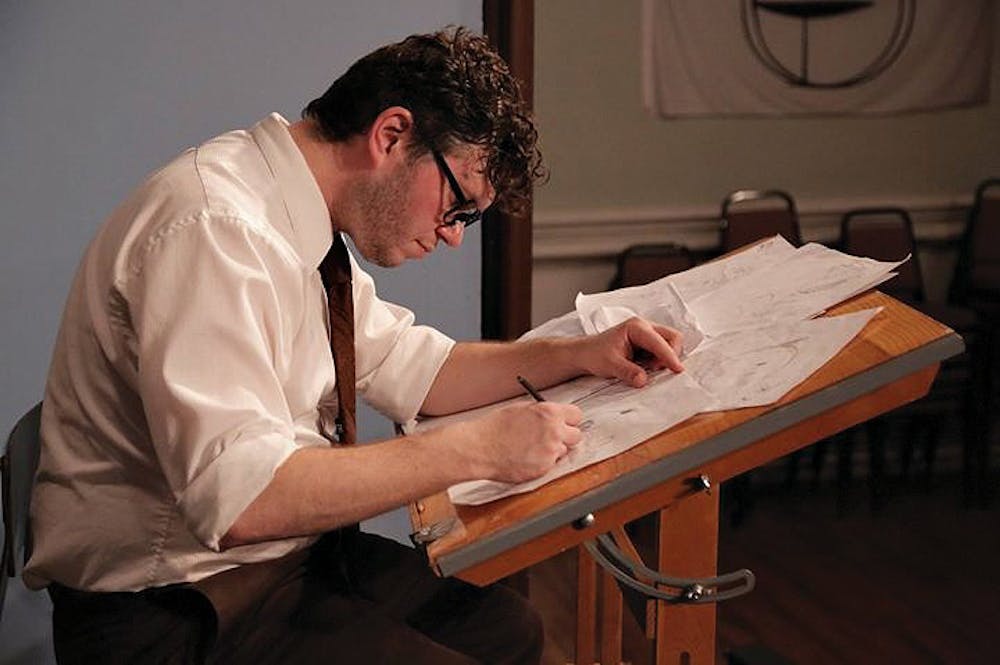“Unhappiness is funny. Happiness is not funny at all.”
Cartoonist Charles Schulz makes this statement in “The Man Who Saw Snoopy,” a play written and directed by Lenny Schwartz that opened Thursday in the Bell Street Chapel’s DayDream Theatre on Federal Hill. He reflects on the changing nature of his comic strips after separating from his wife, Joyce — but this statement also encapsulates the challenges that the character and the play face.
“The Man Who Saw Snoopy” is a biographical play about Schulz, his creativity and the evolution of his famous comic strip, “Peanuts,” which featured iconic characters like Charlie Brown and Lucy van Pelt . But squeezing Schulz’s life and repertoire into a two-hour play is an ambitious project, and its execution at times goes awry.
The set design aptly demonstrates the oddities that make it difficult for Charles to adjust to life outside his imaginary world. A pair of thin, colorful wooden planks, suggesting the blue sky and the grass, stand on opposite ends of the stage. Behind them is an office setting, its walls and furniture completely covered in gray. When the actors move from the foreground to the back of the stage, their vibrant, cutesy costumes — particularly Joyce’s, a typical school uniform with a checkered skirt and a bright red headband holding her ponytail — stand out against the dull background.
No significant set change happens during the play, nor does background music appear more than twice. Considering the stagnant nature of the set, the play is contingent on the actors’ ability to deliver their roles with exuberance. And they all do — to the point of excess.
Perhaps it is the play’s intention, but it is hard to sit and observe when the actors seem like caricatures that don’t belong on stage. A scene when Charles, played by Brad Kirton, meets Donna, his first love, and falls head over heels for her feels like watching a live animation show. Kirton grins ever so widely while standing on his tiptoes, swaying his body back and forth like a pendulum. He bellows his lines, suggesting the character’s anxiety and excitement, albeit in a childish and unconvincing manner.
The affair ends when Donna abruptly announces she is leaving him for another man. Here, Kirton, with his bottom lip sticking out slightly, turns toward the audience and, with his hands, makes the gesture of a heart splitting in half.
Charles then meets Joyce — played by Candice Sampson — who soon becomes his first wife. Their relationship is rather tumultuous. Charles passively acquiesces to her demands for marriage, and, while she is internally aware of the artificiality of this relationship, she remains outwardly in denial.
She barrages Charles with questions like “Do you find me beautiful?” — here, she poses outrageously seductively, squatting and sticking her butt out with her hand on her forehead in a gesture sure to elicit some chuckles — or “Do you like me?” to which Charles pays little attention. Joyce becomes invested in Charles’ cartoons, especially once it becomes clear that his character of Lucy is based on her.
In one scene when Joyce and Charles argue about his cartoons, Charles says, “I don’t think I can ever be happy,” at which point Kirton again looks toward the audience, waiting for laughs. At moments like these, audience members might wonder how to take this play seriously — or not — without being amused in the first place.
The play also struggles with integrating biographical information. In several scenes, whether during conversations with the publisher or arguments with Joyce, the intensity of the dialogue disappears completely when interrupted by sentences like, “In 1958, we moved to San Francisco.” The sudden introduction of dates and the past tense throws off both the viewers and the actors, as the performers’ words become garbled when switching tenses.
But the play turns around after Charles and Joyce’s separation at the start of the second act. Though the theme of unhappiness runs throughout the play, starting at the very beginning when Charles’s creation serves as an escape from his misery, it takes on a much more serious note after intermission. Kirton’s pitch significantly lowers, adding a level of maturity and sincerity to the character.
Here, we meet Jean, played by Sue Dimouro. The third and last significant love interest in Charles’ life, she stands out from the others, with Charles dubbing her “the woman of my reality.” Dimouro performs the role with a composure and demureness more powerful than the other, more boisterous characters.
For those with a personal attachment to or nostalgia for “Peanuts,” the play serves as a nice supplement, providing the biographical and historical context of Charles’ work. And some may find entertainment in the apparent buoyancy of a play that sometimes calls for patience during its moments of corny theatricality.
“The Man Who Saw Snoopy” runs through Nov. 22.

ADVERTISEMENT




